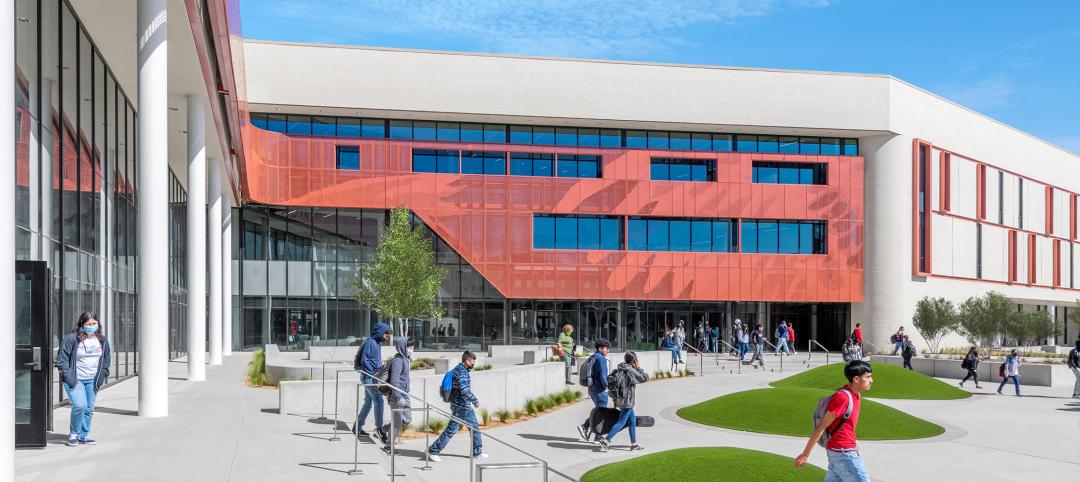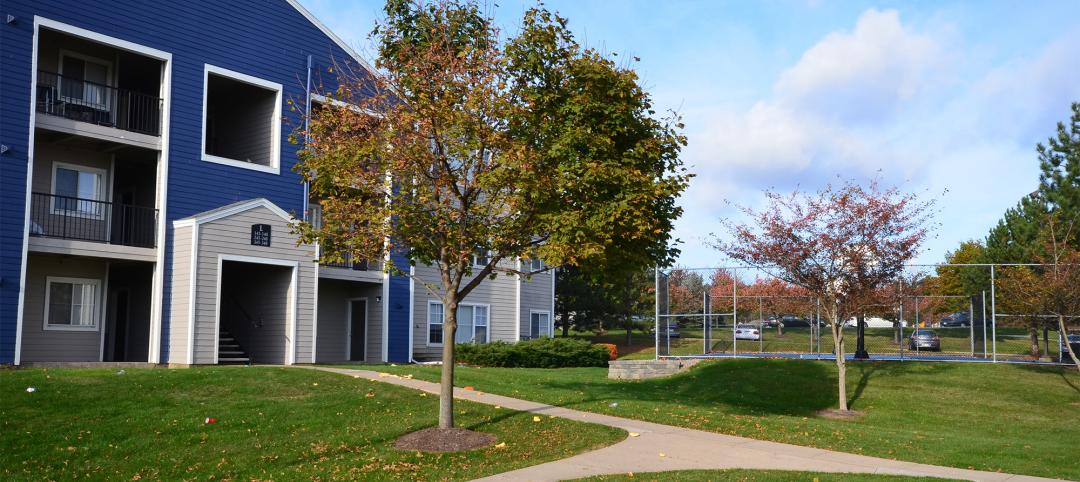When embarking upon a roofing renovation project, one of the first decisions for the Building Team is whether to tear off and replace the existing roof or to overlay the new roof right on top of the old one.
“Typically, you’re reroofing because of leaks or damage to a roof,” says Shad Traylor, AIA, CDT, LEED AP BD+C, a LEED administrator with the design-build firm BRPH, Melbourne, Fla. “A tear-off allows you to inspect the condition of the roof substrate and is more favorable for roof warranties. If the load-bearing capacity of the roof substrate is in question, a tear-off also reduces the additional weight of a second roof.”
However, if the roof has minimal water damage, he adds, reroofing with an overlayment strategy can be the quickest, least expensive, and easiest solution because it eliminates tear-off costs and reduces replacement time. “Overlayment also allows owners to maintain a weather barrier if sensitive equipment and products are installed or stored below the roof,” adds Traylor.
Analysis and testing may be needed to determine if the existing roof structure is adequate to support the added weight of an overlay. This can involve core cuts in strategic areas to analyze material conditions, as well as thermal scans and insulation tests. According to Anthony Vross, owner of Simon Roofing, Youngstown, Ohio, a rule of thumb is that if more than 30-40% of the existing roof is wet, then a tear-off is in order. The same is true in situations where the existing roof system is ponding water and it is not possible to add drains or taper insulation with the perimeters or penetrations at least eight inches higher than the primary roof surface.
In some cases, the decision on the type of reroof may be dictated by the applicable building codes. For example, where two roofing systems are already in place, most jurisdictions won’t allow the addition of a third layer of overlayment. Consequently, a tear-off or full replacement is the only allowable option.
Another instance favoring tear-off is when mechanical equipment upgrades require the roof decking to be rebuilt, in which case tear-off provides the best continuity, says Mark Yanowitz, LEED AP, Assoc. AIA, UCSL, with design-build firm Verdeco Designs, Andover, Mass. “Although there have been significant improvements in new insulation adhesives that make quality overlay roofing projects more viable, tearing off an existing older roof almost always assures a better installation and fewer problems in the future,” he adds. “This is largely because there are no unknowns with attachment issues as to how the previous roof was installed and the integrity of the overall system.”
A number of other factors need to be taken into account, including the building type, location, building usage, roof access, roof traffic, penetrations, decking, and slope.
Other techniques similar to overlayment, such as spray-applied foam products, may be viable alternatives. Another retrofit path for green building projects is the use of a “cool roof” coating, which is fluid-applied directly to the exposed roofing material. Assuming that the roof’s surface is relatively smooth, moisture is not a major concern, and decent drainage is in place, these novel, light-colored roof coatings can be a cost-effective option.
“The extra benefit is that the coating type conforms to all shapes and sizes and seamlessly seals all potential water entry points that typically leak, including flashings, termination bars, corners, pipes, and curbs and the like, which don’t always conform to the shapes of traditional roofing materials,” explains David J. Welte, President of the consulting and commercial building maintenance contractor GreenPROChicago, Lake Forest, Ill.
Vegetated or planted roof coverings may also lend themselves to part of a reroofing strategy as overlayments. For extensive, unoccupied green roofs, a common strategy is to cover existing roofs with plantings in individual trays. With some products, it’s even possible to remove the dividers between the trays, once they’ve grown, at which point they become a seamless blanket of vegetation, says Blake Jackson, LEED AP, Sustainability Practice Leader with Tsoi/Kobus & Associates (www.tka-architects.com), Cambridge, Mass.
“This type of system is most appropriate when you want to cover a surface quickly,” says Jackson. “This will contribute to earning LEED credits and help in terms of building performance and rainwater management.”
In virtually every situation, the sequencing, phasing, and coordination of the roofing work is critical to successful, watertight tear-off installations. Contractors should work from the low point to the top of the roof to prevent back-lap areas that buck water, says David Cook, AIA, Principal Architect in structural and architectural evaluation with CTLGroup (www.C-T-L.com), Skokie, Ill. In addition, sections should be worked in a strategic sequence so that workers don’t have to walk across finished work surfaces.
Protecting the substrate or deck is another key point, says Jason Hand, Vice President of roofing contractor Property Development Solutions (www.pdscompany.com), Lubbock, Texas. This also goes for the building’s contents at times when sections of the roof are fully removed.
“Weather must be tracked and precautions made to dry-in the structure at a moment’s notice,” says Hand. He, too, emphasizes the importance of staging roof work in portions. “The building assemblies should also be torn off in stages to limit exposed area in the event of unexpected precipitation,” says Hand.
Craig R. Garey, owner of roofing contractor WeatherSure Systems (www.weathersuresystems.com), Sheridan, Colo., advises going from the inside of the facility outward in identifying liabilities, risks, deck conditions, and design prior to beginning any renovation. Once a sound plan is in place, a disposal chute is the best way to transfer debris from the roof to the ground, unless the building height exceeds 120 feet.
Yanowitz is a proponent of reusing insulation and stone products to the greatest extent possible once the membrane has been removed and replaced. In cases where on-site reuse isn’t practical, trash hauling companies with off-site recycling facilities are a good option so that contractors don’t have to spend the time segregating products on site.
A roofing retrofit that involves changing a flat roof to a steep slope system can present its own set of difficulties. For starters, the structural engineer must ensure that the weight of the new roof structure meets the proper load bearings and dead-load requirements, says Simon Roofing’s Vross. The architect must verify that the building’s new look meets aesthetic and building code demands.
“Going to a steep slope from a flat roof will change the drainage design, so an engineer will need to be consulted to make sure the existing drainage system can handle the increased flow of the water entering the drains,” he explains. “Due to the amount of air space between the structure and the flat roof, the proper amount of insulation needs to be installed to meet the building code and prevent condensation.”
Related Stories
Giants 400 | Oct 30, 2023
Top 100 K-12 School Construction Firms for 2023
CORE Construction, Gilbane, Balfour Beatty, Skanska USA, and Adolfson & Peterson top BD+C's ranking of the nation's largest K-12 school building contractors and construction management (CM) firms for 2023, as reported in Building Design+Construction's 2023 Giants 400 Report.
Giants 400 | Oct 30, 2023
Top 80 K-12 School Engineering Firms for 2023
AECOM, CMTA, Jacobs, WSP, and IMEG head BD+C's ranking of the nation's largest K-12 school building engineering and engineering/architecture (EA) firms for 2023, as reported in Building Design+Construction's 2023 Giants 400 Report.
MFPRO+ Special Reports | Oct 27, 2023
Download the 2023 Multifamily Annual Report
Welcome to Building Design+Construction and Multifamily Pro+’s first Multifamily Annual Report. This 76-page special report is our first-ever “state of the state” update on the $110 billion multifamily housing construction sector.
Smart Buildings | Oct 27, 2023
Cox Communities partnership levels up smart tech for multifamily customers
Yesterday, Cox Communities announced its partnership with Level Home Inc., a provider of next-generation smart IoT solutions for multifamily customers.
Student Housing | Oct 25, 2023
Pierce Education Properties acquires Penn State student housing
The two communities offer a wide range of amenities, including swimming pools with sun decks, study rooms with complimentary printing services, fitness centers, tennis court, and sand volleyball courts.
Senior Living Design | Oct 19, 2023
Senior living construction poised for steady recovery
Senior housing demand, as measured by the change in occupied units, continued to outpace new supply in the third quarter, according to NIC MAP Vision. It was the ninth consecutive quarter of growth with a net absorption gain. On the supply side, construction starts continued to be limited compared with pre-pandemic levels.
Warehouses | Oct 19, 2023
JLL report outlines 'tremendous potential' for multi-story warehouses
A new category of buildings, multi-story warehouses, is beginning to take hold in the U.S. and their potential is strong. A handful of such facilities, also called “urban logistics buildings” have been built over the past five years, notes a new report by JLL.
Building Materials | Oct 19, 2023
New white papers offer best choices in drywall, flooring, and insulation for embodied carbon and health impacts
“Embodied Carbon and Material Health in Insulation” and “Embodied Carbon and Material Health in Gypsum Drywall and Flooring,” by architecture and design firm Perkins&Will in partnership with the Healthy Building Network, advise on how to select the best low-carbon products with the least impact on human health.
Contractors | Oct 19, 2023
Crane Index indicates slowing private-sector construction
Private-sector construction in major North American cities is slowing, according to the latest RLB Crane Index. The number of tower cranes in use declined 10% since the first quarter of 2023. The index, compiled by consulting firm Rider Levett Bucknall (RLB), found that only two of 14 cities—Boston and Toronto—saw increased crane counts.
Office Buildings | Oct 19, 2023
Proportion of workforce based at home drops to lowest level since pandemic began
The proportion of the U.S. workforce working remotely has dropped considerably since the start of the Covid 19 pandemic, but office vacancy rates continue to rise. Fewer than 26% of households have someone who worked remotely at least one day a week, down sharply from 39% in early 2021, according to the latest Census Bureau Household Pulse Surveys.

















